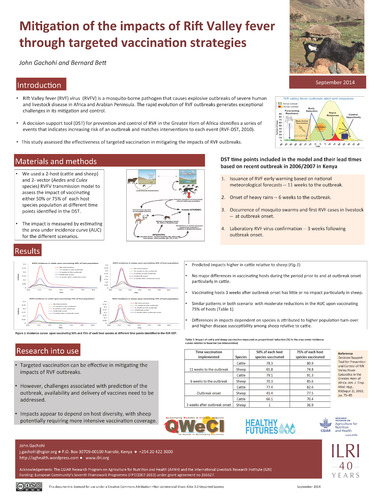Mitigation of the impacts of Rift Valley fever through targeted vaccination strategies
Abstract
The rapid evolution of Rift Valley fever (RVF) outbreaks generates exceptional challenges
in its mitigation and control. A decision-support tool for prevention and control
of RVF in the Greater Horn of Africa identifies a series of events that indicates increasing
risk of an outbreak and matches interventions to each event. Using a 2-host (cattle
and sheep) and 2-vector (Aedes and Culex species) RVF virus transmission model,
we simulated the impact of vaccinating either 50% or 75% of the host population
implemented over a period of 11 and 15 days respectively at different time points
identified in the tool. The time points include issuance of RVF early warning representing
a lead time of 11 weeks based on the recent outbreak in 2006/2007 in Kenya,
onset of heavy rains with a lead time of 6 weeks, occurrence of mosquito swarms and
first RVF cases in livestock at outbreak onset and laboratory RVF virus confirmation
3 weeks after outbreak onset. The impact is measured by estimating the area under
incidence curve (AUC). The results show that vaccinating 50% of the host population
at these time points, that is, early warning, onset of heavy rains, first RVF cases and
laboratory confirmation leads to proportional reductions in AUC of 79 %, 79 %, 77%
and 66% respectively in cattle and 65 %, 70 %, 42% and 1% respectively in sheep,
relative to the baseline (no control) scenario. Increasing vaccination coverage to 75%
during the same time points resulted in moderately higher reductions of 81 %, 91 %,
82% and 71% in cattle and 75 %, 85 %, 77% and 36% in sheep respectively. Delaying
50% vaccination by a week following the onset of outbreak resulted in reductions
of 72% and 31% in cattle and sheep respectively. The results suggest that targeted
vaccination can be effective in mitigating the impacts of RVF outbreaks. However,
challenges associated with prediction of the outbreak, availability and delivery of vaccines
need to be addressed. Impacts appear to depend on host diversity, with sheep
potentially requiring more intensive vaccination coverage. If confirmed by empirical
studies, these findings have important implications for the implementation of riskbased
RVF interventions.

